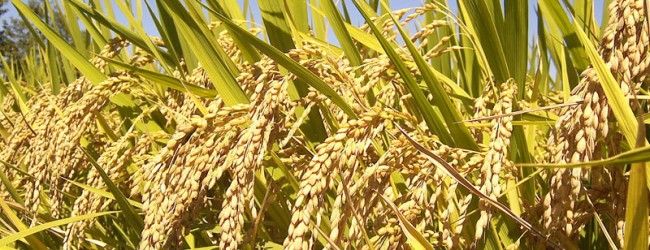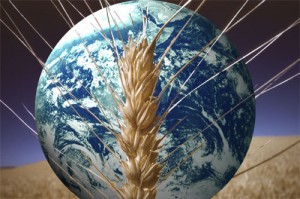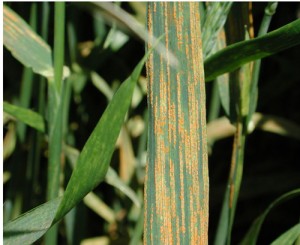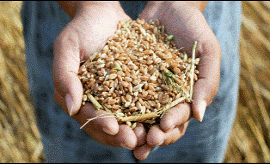
By Paula Hammond
It may look harmless – pretty even – but in the wheat belt that stretches from Morocco to Turkey, it’s a sign of ruined crops and dashed hopes. It’s known as yellow rust, but to farmers in the Muslim world, its presence means just one thing: hunger.
Food for All
According to the Food and Agriculture Organization (FAO), food security “exists when all people, at all times, have physical and economic access to sufficient, safe and nutritious food to meet their dietary needs … for an active and healthy life.” Sadly, such conditions are becoming increasingly rare.
This year, the population of our planet reached seven billion – and it’s still rising. As our resources are stretched to their limit, many nations are already going hungry. The United Nations Food and Agriculture Organization estimated, that nearly 870 million – that’s one in eight people worldwide – were chronically undernourished in 2010-2012.
This situation is expected to be exacerbated by droughts, floods, storms, rising sea levels, and failing crops: the real world effects of what many people still consider to be ‘hypothetical’ climate change.
While it’s known that in some instances, the Greenhouse Gases that cause climate change can encourage crops to grow faster using less water (a process called carbon dioxide fertilization), the long-term prognosis for world food security is poor. In some wheat-growing regions, production is projected to decline by as much as 47 percent as these new, extreme climatic conditions hit home. Nations such as Algeria, Morocco, Pakistan and the Sudan, are among a dozen identified as being most at risk.
Wheat Rust
Wheat is the most important food crop in the world, after rice. Every year, wheat feeds about 2.5 billion people in 90 developing nations. When it comes to food security, though, the world is currently in a state of red alert and much of that alert is focused on wheat crops.
In addition to the threats posed by climate change, crop disease is a significant constraint on food production, and wheat rust is one of the most aggressive diseases to blight agriculture in North Africa, the Middle East and Asia.
Wheat rust (Puccinia striiformis f.sp. tritici), is a parasitic fungus, that kills or stunts bread and durum wheat crops. There are three basic types: stem (black) rust, leaf (brown) rust and yellow (stripe) rust, which leaves characteristic yellow spore lines along the plant’s leaf. The fungus has been known and feared, since human records began. In fact the Romans called it ‘numen’, meaning divine power – and no wonder .
 Historically, wheat rust was believed to be a problem that mainly affected crops in cooler, Northern climates, but it’s an adaptable and tenacious beast. It loves the sort of humid conditions that climate change brings and outbreaks, such as the one that devastated crops in Ethiopia in 2010, have shown that new strains of the fungus are perfectly at home, even in equatorial climates. So, in addition to regions like North America, today’s wheat rust hot spots also include Algeria, Egypt, Lebanon, Iran, Syria, and Yemen. Further more, plant pathology experts at the International Wheat Stripe Rust Symposium, have reported, that under the right conditions, a rust infection could be carried by the wind from one crop to another, in just 24 hours.
Historically, wheat rust was believed to be a problem that mainly affected crops in cooler, Northern climates, but it’s an adaptable and tenacious beast. It loves the sort of humid conditions that climate change brings and outbreaks, such as the one that devastated crops in Ethiopia in 2010, have shown that new strains of the fungus are perfectly at home, even in equatorial climates. So, in addition to regions like North America, today’s wheat rust hot spots also include Algeria, Egypt, Lebanon, Iran, Syria, and Yemen. Further more, plant pathology experts at the International Wheat Stripe Rust Symposium, have reported, that under the right conditions, a rust infection could be carried by the wind from one crop to another, in just 24 hours.
Combining Forces
Given the adaptability and wide geographical spread of the wheat rust fungus, a global pandemic isn’t merely possible; it’s probable.
In any given year, farmers worldwide can expect to lose around two percent of their crop to wheat rust. Yet, when the right conditions occur, as they did in Pakistan in 1977-1978, losses rose to 30 percent in the Punjab. In 2010, the disease inflicted up to 80 percent losses across the Middle East, where wheat provides 40 percent of an average daily calorie intake. In 2013 it struck again, affecting 40 percent of the crops in Morocco. It’s easy to imagine the human cost behind such startling statistics. Fortunately all is not gloom and doom.
Back in the 1970s, the problem faced by farmers in Pakistan was, that they didn’t have any resistant seed – varieties of wheat that had been bred to withstand rust attack. Small landholders had been reluctant to invest in the expensive new seeds, when they’d been getting good crop yields, from tried and tested wheat stocks for decades.![]()
![]()
![]()

The government stepped in, importing resistant seed stocks from both Mexico and India. They also established an Agricultural Research Council, to coordinate research efforts and share their experiences with their neighbours.
Saved by Science?
There’s no doubt, that science is a crucial ally in the battle against wheat rust, whether it’s fungicides to fight the rust when it attacks, or new, resistant seed stocks to stop the fungus in its tracks. Emergency disease control plans, need to be drawn up to cover all crucial crops and – vitally – countries need to educate and encourage new generations of agricultural specialists, plant pathologists and agronomists.
At the forefront of the fight, are organizations such as the International Center for Agricultural Research in the Dry Areas (ICARDA), whose work on yellow rust started in 1977. Their ‘Stripe Rust Network’ now stretches from the highlands of Ethiopia, to the shores of the Mediterranean Sea. The Network has already done invaluable work identifying dominant rust strains, developing and deploying resistant seed varieties, establishing physical spore traps and monitoring and sharing information throughout the Network.
Speaking during the 2nd International Wheat Stripe Rust Symposium, Dr. Mahmoud Solh, Director General of ICARDA, reinforced the message, however, that science is no lone saviour. As Pakistan discovered during its own rust crisis in the 1970s, international co-operation is vital when dealing with an enemy that has no respect for international borders. “We have to focus on partnership and networking, strengthening science and policy dialogue between researchers and national governments, to control stripe rust at both the regional and global level,” he said.
The father of the Green Revolution and Nobel Laureate Dr Norman Borlaug, commented in his seminal article for the New York Times that, “Rust Never Sleeps” . It’s an ever mutating disease and while those in the poorer, developing world may well bear the brunt of future outbreaks, the problem of safeguarding food security is a global one which must be shared by all of mankind.
Paula Hammond is a professional author of over 35 non-fiction books, including popular science volumes on fossils, dinosaurs and endangered animals. She has a passion for learning and the wonders of the natural world
References:
1. World Food Summit Plan of Action, “Rome Declaration on World Food Security”, Nov. 1996. http://www.fao.org/docrep/003/w3613e/w3613e00.htm
2. World Population Clock see: http://www.worldometers.info/world-population/
3. FAO Report, “The State of Food Security in the World”, Rome 2012. http://www.fao.org/docrep/016/i3027e/i3027e00.htm
4. World Bank Report April 2008, “Adaptation and Development”. http://siteresources.worldbank.org/EXTCC/Resources/BaliBreakfast13april.pdf
5. FAO study quoted by the World Watch Institute. http://www.worldwatch.org/node/6271
6. World Bank Report April 2008, “Adaptation and Development”. http://siteresources.worldbank.org/EXTCC/Resources/BaliBreakfast13april.pdf
7. ICARDA. http://www.icarda.org/striperust2014/challenges/
8. International Food Policy Research Institute, Nov. 2009, “Combating Stem and Leaf Rust of Wheat”. http://www.ifpri.org/sites/default/files/publications/ifpridp00910.pdf
9. Dr. Mahmoud Solh, Director General of ICARDIA. See: http://www.icarda.org/blog-content/%5Bnode%3ABlog%20type%5Dqa-dr-mahmoud-solh-mobilizing-international-efforts-defeat-stripe-rust
10. http://www.icarda.org/blog-content/%5Bnode%3ABlog%20type%5Dqa-dr-mahmoud-solh-mobilizing-international-efforts-defeat-stripe-rust
11. New York Times, “Stem Rust Never Sleeps”, 26th April 2008. http://www.nytimes.com/2008/04/26/opinion/26borlaug.html?_r=0
You must be logged in to post a comment.